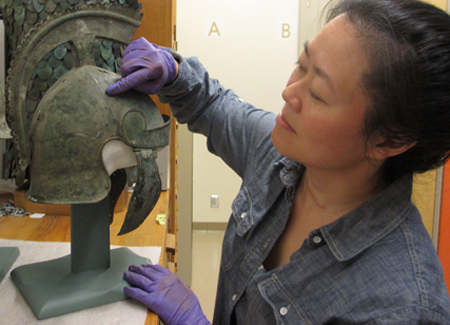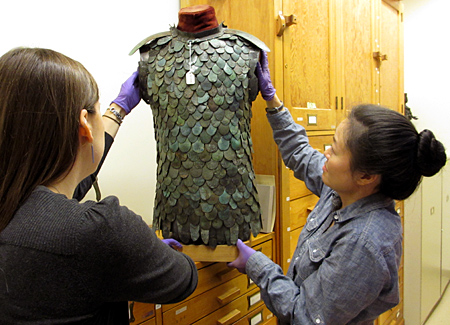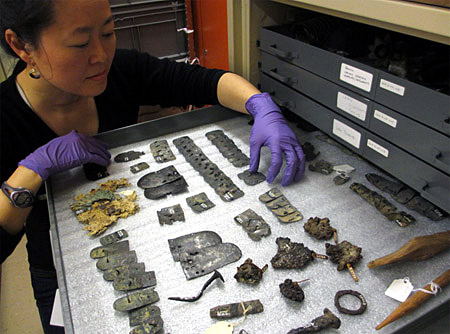Fact & Falsehood in Ancient Roman and Greek objects
This coming weekend at the ROM (June 9-10) we will have Ancient Rome and Greece Weekend! There will be re-enactors demonstrating and displaying arms and armour, ROM experts and objects, an archery range with more re-enactors, and a myriad of activities including make a lucky “bulla”, creating your own mosaic masterpiece and learning the game of “knucklebones”.

Kay Sunahara of the Greek and Roman Section is examining a helmet that suspiciously has parts that belong to different periods. Note also the lines that radiate from the ear gap? These are tell-tale signs that this is not ancient - come see the exhibit to find out why!
As usual, there will be a special exhibition of objects to go with the weekend. In this case these objects are especially cool because they are controversial! The artifacts in the ROM collections come from a variety of sources, some come from proper excavations, but some are acquired through dealers, perhaps as much as a century ago. For the objects that were acquired through dealers we only have our expertise to say if the object is genuine or not. The exhibit will have objects that we have decided are fake, and are shown with examples of the real thing, or an explanation is given as to why it is thought that the artifact is a fake or otherwise suspect. These include objects that were once thought to be important iconic objects in the collection, such as the Minoan lady known as “Our Lady of Sports” and a shirt of scale armour reportedly from Lake Trasimene, Italy.

Here Kay is being assisted by intern Amanda Devitt to move the scale armour allegedly found at Lake Trasimene, Italy – we call it the Legolas armour.
The Minoan figure was on display at the ROM as genuine as recently as 2004. It was bought in 1931 by ROM founder Charles Currelly from Charles Seltman, Lecturer in Classical Art at Cambridge University, who collected and sold many genuine Minoan artefacts. It was very similar to objects excavated in 1902 by Arthur Evans at Knossos in Crete, and Evans himself named it ‘Our Lady of Sports’ and published it as genuine. However, it is now known that many of the men working with Evans on restoring the artefacts were also using their skills to produce copies (sold as modern replicas) and even fakes (sold as being ancient). Many objects in museums today that were not discovered in Evans’ official excavations at Knossos are now thought to be fake, many of which went through Seltman’s hands, notably a figurine sold by Seltman to the Fitzwilliam museum in Cambridge, which has been demonstrated to be a fake.

Here Kay is examining actual fragments of scale armour excavated from the site of Dura-Europos, in Eastern Syria, which will be used to show why the "Trasimene" armour (known in the department as the "Legolas" suit) is a fake.
